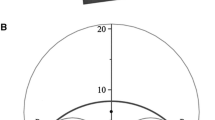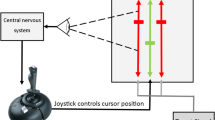Abstract
Most studies on the regulation of speed and trajectory during ellipse drawing have used visual feedback. We used online auditory feedback (sonification) to induce implicit movement changes independently from vision. The sound was produced by filtering a pink noise with a band-pass filter proportional to movement speed. The first experiment was performed in 2D. Healthy participants were asked to repetitively draw ellipses during 45 s trials whilst maintaining a constant sonification pattern (involving pitch variations during the cycle). Perturbations were produced by modifying the slope of the mapping without informing the participants. All participants adapted spontaneously their speed: they went faster if the slope decreased and slower if it increased. Higher velocities were achieved by increasing both the frequency of the movements and the perimeter of the ellipses, but slower velocities were achieved mainly by decreasing the perimeter of the ellipses. The shape and the orientation of the ellipses were not significantly altered. The analysis of the speed–curvature power law parameters showed consistent modulations of the speed gain factor, while the exponent remained stable. The second experiment was performed in 3D and showed similar results, except that the main orientation of the ellipse also varied with the changes in speed. In conclusion, this study demonstrated implicit modulation of movement speed by sonification and robust stability of the ellipse geometry. Participants appeared to limit the decrease in movement frequency during slowing down to maintain a rhythmic and not discrete motor regimen.







Similar content being viewed by others
Notes
Signal with power spectral density inversely proportional to frequency.
The speed RMS, frequency and perimeter were calculated by separate algorithms. It was verified that Vrms was tightly correlated with f*P (r > 0.99 in all the conditions) showing the robustness of the data processing.
References
Abend W, Bizzi E, Morasso P (1982) Human arm trajectory formation. Brain 105:331–348
Athenes S, Sallagoity I, Zanone PG, Albaret JM (2004) Evaluating the coordination dynamics of handwriting. Hum Mov Sci 23:621–641. https://doi.org/10.1016/j.humov.2004.10.004
Berret B, Castanier C, Bastide S, Deroche T (2018) Vigour of self-paced reaching movement: cost of time and individual traits. Sci Rep 8:10655
Bevilacqua F, Boyer EO, Francoise J, Houix O, Susini P, Roby-Brami A, Hanneton S (2016) Sensori-motor learning with movement sonification: perspectives from recent interdisciplinary studies. Front Neurosci 10:385
Boyer EO et al (2013) From ear to hand: the role of the auditory-motor loop in pointing to an auditory source. Front Comput Neurosci 7:26
Boyer EO, Bevilacqua F, Susini P, Hanneton S (2017) Investigating three types of continuous auditory feedback in visuo-manual tracking. Exp Brain Res 235:691–701. https://doi.org/10.1007/s00221-016-4827-x
Cole J, Paillard J (1995) Living without touch and peripheral information about body position and movement : studies with deafferented subjects. In: Bermúdez J (ed) The Body and the Self. MIT Press, Cambridge
Danna J, Athenes S, Zanone PG (2011) Coordination dynamics of elliptic shape drawing: effects of orientation and eccentricity. Hum Mov Sci 30:698–710. https://doi.org/10.1016/j.humov.2010.08.019
Danna J, Velay JL (2017) On the auditory-proprioception substitution hypothesis: movement sonification in two deafferented subjects learning to write new characters. Front Neurosci 11:137. https://doi.org/10.3389/fnins.2017.00137
Darling WG, Cole KJ, Abbs JH (1988) Kinematic variability of grasp movements as a function of practice and movement speed. Exp Brain Res 73:225–235
Desmurget M, Pelisson D, Rossetti Y, Prablanc C (1998) From eye to hand: planning goal-directed movements. Neurosci Biobehav Rev 22:761–788
Dounskaia N, Van Gemmert AW, Stelmach GE (2000) Interjoint coordination during handwriting-like movements. Exp Brain Res 135:127–140
Dubus G, Bresin R (2013) A systematic review of mapping strategies for the sonification of physical quantities. PLoS ONE 8:e82491
Effenberg AO, Schmitz G (2018) Acceleration and deceleration at constant speed: systematic modulation of motion perception by kinematic sonification. Ann NY Acad Sci. https://doi.org/10.1111/nyas.13693
Faraway JJ, Reed MP, Wang J (2007) Modelling three-dimensional trajectories by using Bezier curves with application to hand motion. J R Stat Soc Ser C Appl Stat 56:571–585. https://doi.org/10.1111/j.1467-9876.2007.00592.x
Fitts PM (1954) The information capacity of the human motor system in controlling the amplitude of movement. J Exp Psychol 47:381–391
Fitzgibbon A, Pilu M, Fisher R (1999) Direct least square fitting of ellipses. IEEE Trans Pattern Anal Mach Intell 21:476–480
Flash T, Hogan N (1985) The coordination of arm movements: an experimentally confirmed mathematical model. J Neurosci 5:1688–1703
Gribble P, Ostry D (1996) Origins of the power law relation between movement velocity and curvature: modeling the effects of muscle mechanics and limb dynamics. J Neurophysiol 76:2853–2860
Guigon E, Chafik O, Jarrasse N, Roby-Brami A (2019) Experimental and theoretical study of velocity fluctuations during slow movements in humans. J Neurophysiol 121:715–727. https://doi.org/10.1152/jn.00576.2018
Halir R, Flusser J (1998) Numerically stable direct least squares fitting of ellipses. In: Thalmann NM, Skala V (chairs) WSCG'98, 6th International conference in central europe on computer graphics and visualization, University of West Bohemia, Plzen - Bory, Czech Republic, February 1998, pp 125–132. http://wscg.zcu.cz/wscg1998/wscg98.htm. Accessed Mar 2020
Henriques DY, Cressman EK (2012) Visuomotor adaptation and proprioceptive recalibration. J Mot Behav 44:435–444
Hogan N, Sternad D (2007) On rhythmic and discrete movements: reflections, definitions and implications for motor control. Exp Brain Res 181:13–30
Huh D, Sejnowski TJ (2015) Spectrum of power laws for curved hand movements. Proc Natl Acad Sci USA 112:E3950–3958. https://doi.org/10.1073/pnas.1510208112
Krakauer JW, Mazzoni P (2011) Human sensorimotor learning: adaptation, skill, and beyond. Curr Opin Neurobiol 21:636–644
Lacquaniti F, Terzuolo C, Viviani P (1983) The law relating the kinematic and figural aspects of drawing movements. Acta Psychol (Amst) 54:115–130
Levy-Tzedek S, Krebs HI, Song D, Hogan N, Poizner H (2010) Non-monotonicity on a spatio-temporally defined cyclic task: evidence of two movement types? Exp Brain Res 202:733–746
Levy-Tzedek S, Ben Tov M, Karniel A (2011) Rhythmic movements are larger and faster but with the same frequency on removal of visual feedback. J Neurophysiol 106:2120–2126
Matic A, Gomez-Marin A (2019) A customizable tablet app for hand movement research outside the lab. J Neurosci Methods 328:108398. https://doi.org/10.1016/j.jneumeth.2019.108398
Mechsner F, Stenneken P, Cole J, Aschersleben G, Prinz W (2007) Bimanual circling in deafferented patients: evidence for a role of visual forward models. J Neuropsychol 1:259–282
Meeker K et al (2011) Wavelet measurement suggests cause of period instability in mammalian circadian neurons. J Biol Rhythms 26:353–362
Messier J, Adamovich S, Berkinblit M, Tunik E, Poizner H (2003) Influence of movement speed on accuracy and coordination of reaching movements to memorized targets in three-dimensional space in a deafferented subject. Exp Brain Res 150:399–416
Park SW, Marino H, Charles SK, Sternad D, Hogan N (2017) Moving slowly is hard for humans: limitations of dynamic primitives. J Neurophysiol 118:69–83
Pfann KD, Corcos DM, Moore CG, Hasan Z (2002) Circle-drawing movements at different speeds: role of inertial anisotropy. J Neurophysiol 88:2399–2407
Sallagoity I, Athenes S, Zanone PG, Albaret JM (2004) Stability of coordination patterns in handwriting: effects of speed and hand. Mot Control 8:405–421. https://doi.org/10.1123/mcj.8.4.405
Schaal S, Sternad D (2001) Origins and violations of the 2/3 power law in rhythmic three-dimensional arm movements. Exp Brain Res 136:60–72
Schaffert N, Janzen TB, Mattes K, Thaut MH (2019a) A review on the relationship between sound and movement in sports and rehabilitation. Front Psychol 10:244. https://doi.org/10.3389/fpsyg.2019.00244
Schaffert N, Janzen TB, Mattes K, Thaut MH (2019b) A Review on the Relationship Between Sound and Movement in Sports and Rehabilitation. Front Psychol 10:244. https://doi.org/10.3389/fpsyg.2019.00244
Shadmehr R, Smith MA, Krakauer JW (2010) Error correction, sensory prediction, and adaptation in motor control. Annu Rev Neurosci 33:89–108
Sigrist R, Rauter G, Riener R, Wolf P (2013) Augmented visual, auditory, haptic, and multimodal feedback in motor learning: a review. Psychon Bull Rev 20:21–53
Soechting JF, Terzuolo CA (1986) An algorithm for the generation of curvilinear wrist motion in an arbitrary plane in 3-dimensional space. Neuroscience 19:1393–1405. https://doi.org/10.1016/0306-4522(86)90151-X
Soechting JF, Terzuolo CA (1987) Organization of arm movements in 3-dimensional space—wrist motion is piecewise planar. Neuroscience 23:53–61. https://doi.org/10.1016/0306-4522(87)90270-3
Spencer RM, Ivry RB, Cattaert D, Semjen A (2005) Bimanual coordination during rhythmic movements in the absence of somatosensory feedback. J Neurophysiol 94:2901–2910
Sternad D, de Rugy A, Pataky T, Dean WJ (2002) Interaction of discrete and rhythmic movements over a wide range of periods. Exp Brain Res 147:162–174
Thoret E, Aramaki M, Bringoux L, Ystad S, Kronland-Martinet R (2016) Seeing circles and drawing ellipses: when sound biases reproduction of visual motion. PLoS ONE 11:e0154475
Thoret E, Aramaki M, Kronland-Martinet R, Velay JL, Ystad S (2014) From sound to shape: auditory perception of drawing movements. J Exp Psychol Hum Percept Perform 40:983–994
van der Wel RPRD, Sternad D, Rosenbaum DA (2010) Moving the arm at different rates: slow movements are avoided. J Motor Behav 42:29–36. https://doi.org/10.1080/00222890903267116
Vinken PM, Kroger D, Fehse U, Schmitz G, Brock H, Effenberg AO (2013) Auditory coding of human movement kinematics. Multisens Res 26:533–552
Viviani P, Cenzato M (1985) Segmentation and coupling in complex movements. J Exp Psychol Hum Percep Perform 11:828–845
Viviani P, Flash T (1995) Minimum-jerk, two-thirds power law, and isochrony: converging approaches to movement planning. J Exp Psychol Hum Percept Perform 21:32–53
Viviani P, Stucchi N (1989) The effect of movement velocity on form perception: geometric illusions in dynamic displays. Percept Psychophys 46:266–274
Viviani P, Stucchi N (1992) Biological movements look uniform: evidence of motor-perceptual interactions. J Exp Psychol Hum Percept Perform 18:603–623
Viviani P, Terzuolo C (1982) Trajectory determines movement dynamics. Neuroscience 7:431–437
Wann J, Nimmo-Smith I, Wing AM (1988) Relation between velocity and curvature in movement: equivalence and divergence between a power law and a minimum-jerk model. J Exp Psychol Hum Percept Perform 14:622–637
Zago M, Matic A, Flash T, Gomez-Marin A, Lacquaniti F (2018) The speed-curvature power law of movements: a reappraisal. Exp Brain Res 236:69–82
Acknowledgements
This work was performed within the laboratory of Excellence SMART supported by French state funds managed by the ANR within the “Investissements d’Avenir” program under reference ANR-11-IDEX-0004–02. The authors thank Johanna Robertson for editorial assistance.
Author information
Authors and Affiliations
Corresponding author
Additional information
Communicated by Francesco Lacquaniti.
Publisher's Note
Springer Nature remains neutral with regard to jurisdictional claims in published maps and institutional affiliations.
Electronic supplementary material
Below is the link to the electronic supplementary material.
Rights and permissions
About this article
Cite this article
Boyer, E.O., Bevilacqua, F., Guigon, E. et al. Modulation of ellipses drawing by sonification. Exp Brain Res 238, 1011–1024 (2020). https://doi.org/10.1007/s00221-020-05770-6
Received:
Accepted:
Published:
Issue Date:
DOI: https://doi.org/10.1007/s00221-020-05770-6




